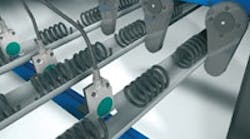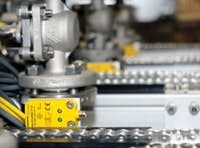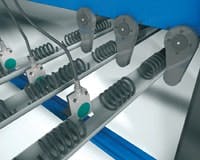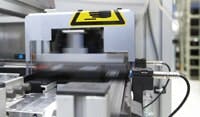We have used proximity switches on our dry material handling machines for a number of years. We are now contemplating an upgrade to programmable proximity switches. This should allow us to improve performance by fine-tuning switch characteristics via software. It should also allow us to stock fewer different types of switches. Are these and other improvements worth the time, the trouble and the expense of upgrading from standard to programmable proximity switches?
ANSWERS
Three Factors
There are three factors to consider when evaluating a change from standard to smart proximity sensors: performance gains vs.increased cost, end-user MRO challenges and availability.
- Performance gains vs. increased cost. The OEM must consider how the increased cost of the smart switch compares with the improved functionality. This includes the material cost difference between the two devices, the additional time cost of programming the devices vs. standard set-and-forget and the cost decreases from reducing inventory. Only the OEM can answer these questions.
- End-user MRO. The proximity switch market is becoming more of a commodity market with each passing year. This is generally due to increased competition and ultimately leads to reduced cost for standard switches. The use of smart switches will not only lead to increased material cost for the end user when replacing one of these devices, but also an increased requirement for maintenance training on how to program the switches. The former can happen often in the material handling industry, while the latter can lead to increased downtime. The OEM should consider both of these points and discuss them with the end user before moving forward.
- Availability. The last thing an end user can stomach is not being able to get a switch when the machine is down. This is typically not a problem with standard proximity switches because, as a commodity item, they are readily available from many companies. Smart switches, however, are typically proprietary and difficult to replace between suppliers. This must be factored in over the lifecycle of the machine.
In the end, a good relationship between the OEM and end user will help both discuss and understand the impact of going with smart devices vs. standard proximity switches. Only then can the best decision be made.
Garrett Place
Product Manager, Position Sensors and Object Evaluation
ifm efector
Sensors with a preset fixed range eliminate the need to relabel and provide additional tools to customers.
Programming Headache
The hassle that accompanies programming your own sensor outweighs the benefits of properly choosing a sensor with the fixed range at the start. With programmable sensors, the OEM assumes the responsibility of relabeling the sensor and providing the customer with the necessary tools to program a replacement.
Tony Udelhoven
Division Director, Sensors
Turck
Configure It Out
There is a variety of solid-state proximity sensing technologies available to the machine builder for consideration. The most common sensing technologies in use are inductive metal, photoelectric and ultrasonic proximity sensors. These three sensing technologies allow the machine builder to support a wide variety of sensing applications with a limited variety of configurable sensor products.
Rather than having to maintain a large stock of various dedicated sensors for addressing several different sensing applications, a configurable sensor can be easily programmed or adapted by the machine builder to support those different sensing applications.
With configurable sensor products, the machine builder is afforded these sensing considerations: inductive metal proximity sensors with either shielded or non-shielded configurability; photoelectric sensors with configurable diffuse, diffuse with background suppression, polarized retro-reflective or thru-beam sensing functionality and programmable N.O or N.C. output; and ultrasonic configurable proximity sensors for performing inductive proximity sensing tasks, but with a longer sensing range, or, for performing photoelectric sensing tasks where optically challenged with respect to color, transparency, ambient light, condensation or dirt.
The machine builder will find the cost comparison between dedicated and configurable sensor products to be surprisingly similar. Any added cost in replacing dedicated sensors with configurable sensors will be offset by the savings realized in maintaining a smaller replacement sensor inventory.
Craig Eilmann
Product Application Engineering
Schneider Electric
Get With the Program
The upgrade from a nonprogrammable to a programmable proximity switch has many benefits. You will need fewer sensor part numbers in your system, which results in less inventory and a reduced cost.
Manufacture time will also be reduced because of the simpler and faster installation time of the sensor. The less time you have to spend on installation, the more money you will save.
There is less confusion in production with fewer part numbers. It will be easier for the mechanical field representative to exchange one sensor than multiple sensors. This will result in a simpler and shorter installation.
Alex Gasser
Business Development Manager
Baumer
You’re All Setpoint
While it is not clear which characteristics of the proximity switch need to be fine-tuned, some capacitive and inductive (eddy-current) devices do offer a level of programmability. Some sensors offer an adjustable setpoint. The setpoint determines the nearness of the object required to activate the proximity switch. Depending on the sensor, this adjustment may be made with a screw adjustment, a push button or remotely from a PLC or other controller output. If the sensing application requires more than simple presence/absence but requires an adjustable setpoint, these sensors are a good solution. The typical setup sequence involves positioning a target at the location where the proximity switch is to trigger and adjusting the sensor to trigger at that point.
While these sensors do cost more, if the alternative requires a large stock of different sensors and the labor to change them for different runs, then the programmable sensors can pay for themselves.
Don Martin
President
Lion Precision
Proximity switches can be used for detecting metal slide carriers at the production line.
Remove the Mask
The machine builder’s description does not reveal the underlying reasons for needing to fine-tune the switch characteristics with a frequency that necessitates doing it via software. It could be production runs of materials of different metallic composition, inconsistent formulation, vibration in the line or compensation for temperature changes, flexibility and ease of operation, to name a few.
The trade-off here goes beyond choosing a programmable proximity switch that costs 4 or more times the cost of a standard proximity switch. It also adds an engineering labor component to the process—fine-tuning via software—that further increases customers’ cost of operating the machines. It is worthwhile to test one of the programmable proximity sensors to see if it actually improves efficiency, accuracy and quality in production enough to offset the increased hardware and labor costs. The choice also ties the machine builder to a single vendor that can add a potential for line shutdown if the specialized parts are not readily available. In today’s competitive marketplace, where reliable standard proximity sensors are widely available from a range of suppliers, most machine builders are looking to decrease the cost of their control solution and not lock in their customers to a single part number or supplier.
Certainly, there are applications that call for the flexibility and adaptability offered by a programmable proximity switch, but those are often niche applications that require increased precision or fine positioning not offered by a standard proximity switch. Is the fine-tuning requirement masking what is actually the need for an edge control or measurement type of solution? These types of applications often require an analog output in addition to a discrete output. In these cases, the increased performance, quality and throughput delivered by the machine or system employing programmable or measuring proximity switches justifies the increased cost and convenience. The machine builder will want to make sure the system is easy to maintain for the customer to keep the cost of ownership down.
Gilbert Guajardo
Product Marketing Manager for Proximity Sensors
Omron Electronics
Stay Off the Field
It makes sense to fine-tune sensors based on application requirements via software. There are two things that users should focus on.
- Fine-tuned sensors can increase productivity and efficiency, while decreasing the failures.
- Setting up fewer part numbers in the parts pool can reduce the inventory cost and makes it easier to select a sensor.
There are two ways we can do this: the method that Sick recommends and the method that it does not recommend.
Sick does not recommend having a field-programmable sensor programmed in the field via software by the user.
Why don’t we recommend this method?
- Cost of setting up sensors: Each sensor needs to be programmed to a specific parameter by the user. The technicians need to be trained to use the programming tool. This increases the cost of installation.
- Cost of sensor: Field-programmable sensors are more costly than standard inductive sensors. The market pricing of field-programmable sensors is substantially higher than a proximity sensor that can do the job.
- Cost of repair: During the time it takes to find the right technician and the right programming tools and to figure out the right parameter settings for the sensor, you lose very valuable machine time, man time and material while paying more money for the sensor.
Sick recommends understanding the application and customer requirements thoroughly. This approach will evolve without providing additional effort to the customer while providing increased productivity, efficiency with fewer failures, fewer part numbers and lower cost.
Sick has designed a custom ASIC-based inductive proximity sensor called IME. The IME products are programmed in the factory and locked at the last step of our production line. As a result, we eliminate the production tolerances, which increase the performance of the inductive proximity sensor. We can standardize sensors based on customer’s specified parameters and ship the programmed and tested sensors.
Standardization is basically choosing same barrel type sensors and using the same part numbers while avoiding unnecessary variations such as using NPN and PNP output sensors on the same application. Sick can program the IME sensor to customers’ requirements. Sick’s value-add process addresses the performance improvement for the machine while removing the burden from the customer to program and fine tune their own sensors.
The Future of Inductive Proximity Sensors: IO-Link
Once IO-Link is a more accepted communication protocol, the sensing nodes in the automation system can be programmed and monitored based on where they are installed. IO-Link can provide the optimal solution of all the benefits of performance improvement with fine tuning, inventory and cost reduction and also monitoring functionality. IO-link offers bi-directional point-to-point communication with standard sensor/ actuator cable, bi-directional serial communication of process and service data, such as switching status, sensing range, contamination level and hysteresis. A quick benefit summary of IO-Link is:
- Reduction of variants
- Reduction of machine downtime and changeover time
- Higher line security by continuous documentation of the configuration
- Reduction of maintenance costs by preventive and problem-oriented maintenance
- Shorter machine downtimes due to sophisticated diagnostics
- Backward compatibility to standard I/O.
Serdar Guvenc
Industrial Sensors Product Manager
Sick
June's Problem
I'm convinced that there's value to us using fiberoptic cabling for some of our long and noisy control signal connections between machine trains. But we have a degree of regular, routine reconfiguration of the machines that means making, breaking and changing control and signal wiring configurations. It looks like it's too hard, or is too much of an art, to dependably make these fiberoptic cable and connector connections ourselves, and we'd be forced to go outside for it each time. Advice please.
Send us a few focused paragraphs addressing the machine builder question, not a product plug. We'll include your response in the print issue and also post it on ControlDesign.com. Send visuals if you would like - a sketch is fine.
Please include your name, title, company name, website URL (or city and state if you don't have a URL) in your response. Please call me at 630/467-1300, x444 or e-mail me at [email protected] with any questions.
Continue Reading

Leaders relevant to this article:






